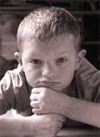 "My husband changes diapers once in a blue moon".
"My husband changes diapers once in a blue moon".You have all heard the expression. It is really our way of saying it NEVER happens; kind of like "When pigs fly".
Well, if you believe that a blue moon never happens, you are wrong. In fact, this New Years Eve, we'll have a blue moon.
A blue moon is a full moon that is not timed to the regular monthly pattern. Most years have twelve full moons which occur approximately monthly, but in addition to those twelve full lunar cycles, each solar calendar year contains an excess of roughly eleven days compared to the lunar year. The extra days accumulate, so that every two or three years (on average about every 2.7154 years), there is an extra full moon. The extra moon is called a "blue moon."
Now, before you are HORRIBLY disappointed on New Years Eve, the blue moon...IS NOT BLUE.
The New Year's Eve non-blue blue moon will be visible in the United States, Canada, Europe, South America and Africa. For partygoers in Australia and Asia, the full moon does not show up until New Year's Day, making January a blue moon month for them.
However, the Eastern Hemisphere can celebrate with a partial lunar eclipse on New Year's Eve when part of the moon enters the Earth's shadow. The eclipse will not be visible in the Americas.
A full moon occurred on Dec. 2 this year. It will appear again on Thursday in time for the New Year's countdown.
The popular definition of blue moon came about after a writer for Sky&Telescope magazine in 1946 misinterpreted the Maine Farmer's Almanac and labeled a blue moon as the second full moon in a month. In fact, the almanac defined a blue moon as the third full moon in a season with four full moons, not the usual three.
Though Sky&Telescope corrected the error decades later, the definition caught on.
For purists, however, this New Year's Eve full moon doesn't even qualify as a blue moon. It's just the first full moon of the winter season.
Any way you look at, it won't be blue, but it WILL be interesting and could be a great way to begin some research into lunar cycles.
Now, if you would like to begin a HISTORY lesson, show your kids how old you are and try singing the rest of this...
"Blue Moon, you saw me standing alone, Without a dream in my heart, Without a love of my own..."



























 Greetings to all of our new friends in Mundelein!
Greetings to all of our new friends in Mundelein!






